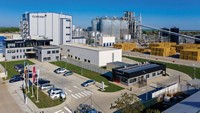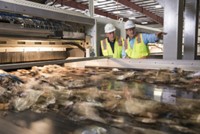Advertisement
Grab your lab coat. Let's get started
Welcome!
Welcome!
Create an account below to get 6 C&EN articles per month, receive newsletters and more - all free.
It seems this is your first time logging in online. Please enter the following information to continue.
As an ACS member you automatically get access to this site. All we need is few more details to create your reading experience.
Not you? Sign in with a different account.
Not you? Sign in with a different account.
ERROR 1
ERROR 1
ERROR 2
ERROR 2
ERROR 2
ERROR 2
ERROR 2
Password and Confirm password must match.
If you have an ACS member number, please enter it here so we can link this account to your membership. (optional)
ERROR 2
ACS values your privacy. By submitting your information, you are gaining access to C&EN and subscribing to our weekly newsletter. We use the information you provide to make your reading experience better, and we will never sell your data to third party members.
Business
Put A Tree In Your Tank
Thermochemical processes are making headway as a route to cellulosic ethanol and other biofuels
by Alexander H. Tullo
November 26, 2007
| A version of this story appeared in
Volume 85, Issue 48

EARLIER THIS MONTH, Range Fuels broke ground on an ethanol plant in Soperton, Ga., which will be the first of its kind in the U.S. It will make so-called cellulosic ethanol by harnessing thermochemical conversion to break down wood residues from the forest products industry.
Fuels made from cellulosic biomass have been garnering attention for their potential to help wean consumers from fossil fuels. Unlike the conventional ethanol facilities that now speckle the Midwest, plants that make cellulose-based fuels don't depend on crops that are normally used for food. Range Fuels estimates that Georgia's forests alone can support the production of 2 billion gal of cellulosic ethanol per year.
To date, much of the focus in cellulosic biofuels has been on biochemical processes. These approaches use enzymes to break down cellulose into sugars, which are then fermented into ethanol.
But Range Fuels and others want to employ thermochemical means instead. They typically begin with gasification, whereby heat and oxygen or steam break down biomass into a synthesis gas consisting mostly of hydrogen, carbon monoxide, and carbon dioxide. This syngas is then converted into ethanol or diesel fuel, often in configurations resembling the Fischer-Tropsch process used today to make synthetic fuels.
Because backers of both technologies are barely cracking the demonstration phase, it is hard to say which one is more competitive. However, observers say thermochemical conversion has some distinct advantages.

One is that a single facility can process a wide variety of biomass. Lou Burke, biofuels manager at oil giant ConocoPhillips, notes that biochemical processes, in contrast, generally depend on specific enzymes tailored to a specific feedstock such as corn stover or wheat straw. "You tend to have one bug for one feedstock," he says. "If you use gasification, you can take a mixed feedstock."
Another is that the fundamentals underlying gasification and Fischer-Tropsch conversion are well known, points out Ron Cascone, director of biofuels development for the consulting firm Nexant Chem Systems. Though new to biomass-based fuels, gasification has been used for nearly a century to make fuels, fertilizers, and chemicals from natural gas or coal.
The Fischer-Tropsch process was developed in Germany in the 1920s to make fuels from coal. Many of the practices being considered by biofuels makers are Fischer-Tropsch processes that have been adapted with new catalysts to make mixed alcohols or ethanol instead of paraffinic hydrocarbons. "It is a fungible technology," Cascone says. "If you can do it with coal, or you can do it with syngas made from natural gas, then you can do it with gasified biomass, as long as you adjust the ratios of carbon monoxide, carbon dioxide, and water."
FURTHERMORE, thermochemical conversion can have a special fit for certain companies. Papermakers, for instance, are looking at the technology because it yields heat that can be cycled back to the mill.
Oil companies see other advantages. According to ConocoPhillips' Burke, thermochemical processes are analogous to the company's core petroleum fuels business. "We think it is what we know, because we are basically a chemical engineering company," he says. "We believe the speed of the process will lend itself to large scale better than certain biological processes, where you have substantial residence, or waiting times, for the organisms or enzymes to do their work."
While ConocoPhillips is researching biochemical processes, Burke says, the company is doing more work in thermochemical conversion. It has a $22.5 million research program with Iowa State University to develop thermochemical technologies, including gasification and fast pyrolysis, a technique that uses heat in the absence of oxygen to produce a liquid that can be upgraded into fuels.
Thermochemical conversion, Burke notes, yields fuels that can be better integrated into refining and downstream infrastructure than present-day biofuels. Ethanol's oxygen content and hygroscopicity keep it from being shipped in pipelines. But a biocrude based on a thermochemical process might be used to make conventional fuels. "The dream is to take a tree and make gasoline," he says.
ConocoPhillips is close to this dream already at a refinery in Cork, Ireland, where it has commercialized a thermal depolymerization process to convert soybean oil into diesel fuel and propane. Separately, in an alliance with meat processor Tyson Foods, the firm is using the same technology to make diesel from pork, beef, and poultry fat.
SMALLER COMPANIES are advancing thermochemical processes with the help of funds from the Department of Energy. In February, DOE awarded $385 million for six biorefinery projects that together would produce more than 130 million gal of ethanol per year. Of the projects, Range Fuels' is the only one that's wholly thermochemical; three others use thermochemical techniques or acid hydrolysis to break down cellulose. The final two are wholly biochemical processes based on enzymes—one led by enzyme maker Iogen and another by the ethanol producer Poet Energy.
Range Fuels has received a $76 million award from DOE for its Soperton plant, which will make 20 million gal per year. Its process gasifies the biomass into syngas, which is then converted into mixed alcohols by using a proprietary catalyst. Subsequent processing steps maximize the amount of ethanol produced. The company tested the technology for more than seven years at a pilot plant in Colorado, where it experimented with nearly 30 different types of feedstock. It envisages a 100 million-gal ethanol plant at the Georgia site as biomass becomes available.
Menlo Park, Calif.-based Khosla Ventures, which invests in alternative energy start-ups, is backing Range Fuels. Khosla also recently formed a joint venture with BIOeCON, a Dutch firm that is trying to advance a biomass catalytic cracking technology.
Range Fuels is not alone in focusing on thermochemical processes. Alico, a La Belle, Fla., land management company, is planning a project that incorporates thermochemical processing. The plant will use a gasification step followed by fermentation of the syngas to make ethanol. It could receive $33 million in DOE grants to build a plant that will make 7 million gal of ethanol per year from wood and vegetative wastes such as citrus peels. A second stage of the project could make 14 million gal of ethanol per year, plus ammonia, hydrogen, and 6 MW of power.
Meanwhile, two companies will employ two unique plant configurations to produce ethanol. The Spanish firm Abengoa Bioenergy is receiving a $76 million grant from DOE to help build a facility in Colwich, Kan., that will combine various technologies. An enzymatic hydrolysis will break down cellulose into sugars that will subsequently be fermented into 15 million gal of ethanol per year. The site will also employ conventional starch fermentation. Energy will come from a biomass gasification plant.
Similarly, Irvine, Calif.-based BlueFire Ethanol is in line for a $40 million grant to build a unit to make nearly 20 million gal of ethanol per year from green waste and wood waste diverted from landfills. It will use acid hydrolysis followed by fermentation.
For companies not part of this round of government awards, biofuels are often being developed in synergy with existing businesses. For example, the new owners of a 100-year-old paper mill in Park Falls, Wis., see biofuels as a part of a revamp to make their facility more competitive.
Bob Byrne, president of Flambeau River Papers, explains that the market for his company's printing papers has been declining by about 3% per year because of digitization of communication. In addition, cheaper papers from South America made from eucalyptus trees have been flooding the market. He thinks biofuels can help make up for the lost revenue. "Rather than just be in the paper industry, we would like to be in both the paper and the transportation fuels industry," he says.
Byrne's proposed plant would gasify about 220,000 tons of forest residuals per year. A process such as Fischer-Tropsch conversion would catalytically convert the resulting syngas into about 4.6 million gal of ethanol.
SENDING EXCESS heat and electricity to the mill's pulpers and dryers would make the process economical for the company. Although the new owners have spent millions of dollars to upgrade the mill, its economics are still "marginal" in today's environment, Byrne says. "The biofuels project makes the mill that much stronger."
Alexander A. Koukoulas, principal and senior technical consultant for the proposed biofuels plant with ANL Consultants, says the paper industry is ideally suited to make cellulosic biofuels because it has a core competency in handling large amounts of biomass. "The paper industry knows how to transport biomass and knows how to convert it," he says.
Koukoulas also notes that the paper industry is starting off with an advantageous raw material-wood-that has a higher energy density than cellulosic ethanol feedstocks such as corn stover. This makes wood more economical to transport and store.
But the proposed plant comes with a hefty price tag: $84 million, far in excess of the cost of the paper mill itself. Flambeau River has applied for a $30 million DOE grant. Byrne says the company will likely proceed even without government funding, but he concedes that the money would help.
Flambeau isn't the only paper company interested in biofuels. Finnish papermaker UPM is testing gasification technology at a pilot plant in Des Plaines, Ill., run by the Gas Technology Institute, a nonprofit research group. Hans Sohlström, UPM's executive vice president of business development for biofuels and biochemicals, says the aim of the project is to perfect the gasification and cleanup of synthesis gas for potential use in Fischer-Tropsch conversion into diesel.
The company intends to commercialize the process at one of its paper mills in Finland, Germany, France, or the U.K. Sohlström says his company will use heat from the process in its paper-making operations. "The energy integration aspect is essential for the overall economics," he says.
A German firm, Choren Industries, is also focused on gasifying woody biomass to yield diesel, with the backing of Royal Dutch/Shell and the German automakers Volkswagen and Daimler. The company's two-stage gasification scheme converts the biomass into coke and then synthesis gas. A Shell-developed Fischer-Tropsch process uses a cobalt catalyst to convert the gas into a paraffinic wax, which is cracked to yield diesel and naphtha.
CHOREN HAS operated a pilot plant since early 2003. Early next year, the company will scale up the process at its Freiberg, Germany, headquarters to a capacity of 4.7 million gal of fuel per year. The company intends to begin construction on a 65 million-gal unit in 2009.
Tom Blades, Choren's chief executive officer, says the process can consume a variety of feedstocks. "That is the beauty of the biomass-to-liquids process; we can use any kind of organic feedstock," he says. "But we have a preference for woody biomass," particularly waste wood from construction.
Blades anticipates integration opportunities for the process, particularly with pulp and paper companies because of the heat output and the feedstock they could provide. He also sees synergies with chemical plants that can use the steam and the naphtha.
Such synergies lead experts to conclude that thermochemical conversion is a serious contender for making next-generation, biomass-based fuels. While thermochemical and fermentation technologies are too new for a thorough comparison, Nexant's Cascone says the chemical approach seems like a good fit for some companies. "Thermochemical conversion can be competitive with fermentation," he says.





Join the conversation
Contact the reporter
Submit a Letter to the Editor for publication
Engage with us on Twitter